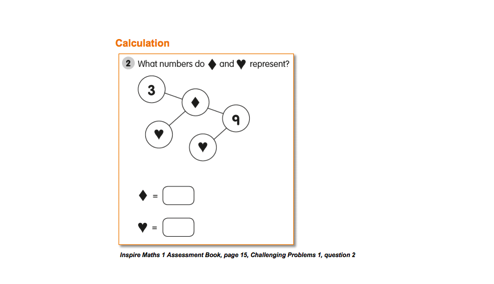In defence of 'small' numbers (or no numbers at all)
How to introduce logical mathematical thinking
Barbara Langford, Deputy Head Academic and Head of Mathematics at Westbourne House, shares the concept behind the Pre-Prep’s focus on numbers less than 10. It is a fascinating insight into the teaching of maths in the Pre-Prep and the Singapore Maths method used throughout the whole school. Mrs Langford also shares examples of the High Performance Learning (HPL) skills pupils start to develop within the maths curriculum. The article concludes with an overview of the school’s overarching vision to empower all pupils to be intellectually and socially confident and work-place and life-ready.
I am often asked why we stick to ‘small’ numbers (numbers less than 10) for so long in the Pre-Prep, when children can happily recite numbers to 100. Let me assure you that this is a deliberate move to encourage young children to think mathematically right from the start - a skill which will serve them well when they do start using big numbers.
The understanding of Base 10 (the decimal number system that we use every day) and pre-algebra work on reverse calculations can all be done using the first few numbers (or no numbers at all) and, as these are the foundations of maths, it is important that we embed these essentials from the start.
Equally important is the realisation that maths is not just numbers. Maths gives us the ability to think logically, to be intellectually confident and to be able to express opinions succinctly. It helps us learn to generalise and extrapolate knowledge to other similar situations. These are the High Performance Learning skills of Meta-thinking and Linking that will help children succeed in the future (as well as pass maths exams!).
The initial step is to practise games like 'How Many Beans in the Pot?' to get children to start thinking about missing numbers.
 I put 9 beans in this pot. I take out 5, how many are left?
I put 9 beans in this pot. I take out 5, how many are left?
This naturally leads onto questions like

Sums like this are the start of algebra: assigning a symbol to a number and getting used to the idea that the symbol can change its value depending on the question.
Algebra can also be introduced using no numbers at all, but using Cuisenaire rods or equivalent.

In this example, 1 yellow = 1 green + 1 red and a red = 1 yellow – 1 green.
To express the same thing in a different way, y = g + r therefore r = y - g
We can extrapolate this further: what values could they take? How many solutions can you find with yellow being a single digit number? How do you know you have found all the solutions?
This sort of questioning not only introduces algebra but also requires children to be able to express themselves clearly and to think logically - the High Performance skill of Analysing.
When we use ‘small numbers’, children have a greater understanding of them and this gives them the confidence to play with the operations. This intellectual playfulness helps pupils become creative learners, as well as establishing a complete understanding of mathematical operations and the link between them all. The maths does not need to be easy, as this Year 1 example of a part, part, whole model shows.

An example of logical thinking and a strong understanding of basic operations are Kenken puzzles.
The goal of a Kenken is to fill the whole grid with numbers, making sure that no number is repeated in any row or column. The heavily outlined areas are called cages, the top left-hand corner of each cage has a target number and a mathematical operation. For example, 5+ means the numbers in the cage must add up to make 5, and 3– means that the difference between the numbers must be 3.
The following Kenken puzzle only uses the numbers below 10 but is surprisingly tricky.

These operations require pupils not only to know all their number bonds within 10 but also the difference between numbers. In order to complete the puzzle, the pupil needs to be able to manipulate their knowledge and be able to think flexibly, discarding one solution for another. This demonstrates the High Performance skill of Agile.
HPL and Westbourne House’s Future Focus
Our vision is to equip our pupils with the skills and tools they’ll need to confidently create the world they’ll want to live in.
Top business leaders predict certain skills will be critical in the work place of tomorrow: problem-solving, critical thinking, creativity, people management, emotional intelligence, decision-making and cognitive flexibility.
We weave very many threads into school life to create an experience for our pupils that builds these skills including, for example, our broad and diverse curriculum, the 30+ leadership programmes and dedicated Learning4Life lessons.
In addition, we put the development of these future skills, which also include important attitudes and attributes, centre stage in every classroom via the High Performance Learning (HPL) Framework. Through this teaching and learning system, pupils and staff share a consistent educational language, which enables specific skills to be discussed, highlighted, encouraged and celebrated.
The key thinking skills we highlight are:
![]() Meta-thinking: the ability to think about your thinking and self-regulate
Meta-thinking: the ability to think about your thinking and self-regulate
because thinking about how you think helps you to be aware of your own strengths and weaknesses and develops intellectual confidence and helps with strategy planning.
![]() Analysing: making sense of information, thinking logically, finding the right approach
Analysing: making sense of information, thinking logically, finding the right approach
because being able to break down complex and multi-step problems and working with precision helps to deepen understanding.
![]() Linking: using the things we already know to understand new ideas and listen to the views of others to see the big picture
Linking: using the things we already know to understand new ideas and listen to the views of others to see the big picture
because academic success comes when individuals are able to construct understanding and meaning by linking and seeing the connections to generalise and make predictions.
![]() Realising: using skills accurately and automatically
Realising: using skills accurately and automatically
because the more you practise skills the more natural they become and you can deploy them quickly and automatically, leaving your brain free to work on more complex thinking.
The key values, attributes and attitudes we highlight are:
![]() Agile: being open-minded and thinking around a problem to explore different paths
Agile: being open-minded and thinking around a problem to explore different paths
because it is important to develop an enquiring approach to learning, developing children’s natural curiosity letting them ask questions about their learning and seeking their own ways to find answers.
![]() Hardworking: deliberate practice and working to reach targets, even when it is hard
Hardworking: deliberate practice and working to reach targets, even when it is hard
because no matter how easily you learn you will not be successful in the long run if you don’t practice and have perseverance and resilience to overcome the difficult times.
![]() Empathy: listening and looking out for others as part of a team
Empathy: listening and looking out for others as part of a team
because when you work collaboratively you develop leadership attributes, a concern for society and the confidence to change your beliefs when given additional information.
If you have any questions about High Performance Learning as it relates to learning maths or any other subject, please do feel free to email me blangford@westbournehouse.org



